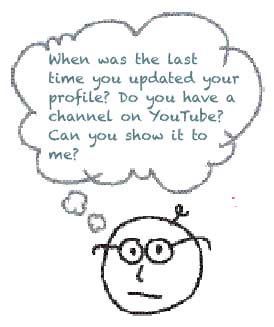They’re unlike anything furniture retailers have ever seen.
Have you ever read about a time when people believed the world was flat? Or when it was thought the sun revolved around the earth? Sure you have. Well, just as accepted truth about our physical world changes, so do our notions about doing business. In fact, the business landscape is littered with the carcasses of people who were certain they knew the truth… right up until the day they found out that they didn’t!
So that your furniture business doesn’t end up on that trash heap of out dated truths, you should take some time, before it is too late, to review the kinds of people you hire.

Since I started in the furniture industry in the good ole’ days of the late 1980s, we’ve been driven by “pull marketing." Pull marketing tells the consumer what they need in a force-fed, cutely-packaged, polished storyline. Pull marketing is the way that most furniture retailers find their way into their customer’s wallets, and it hasn’t changed much since the days when companies such as Procter & Gamble, Coca Cola and GM perfected the craft of top-down control of the message. When delivered effectively, pull marketing even became part of the fabric of culture. Most of us wanted “to teach the world to sing” or make summertime complete with “baseball, hotdogs, apple pie and Chevrolet.”
The era of pull marketing has come to a screeching halt. It’s no longer enough to design a furniture collection, build it, bring it to market with a slick ad campaign, sell it to retailers and ultimately deliver it to customer’s homes. A decade after 9/11, the introduction of the DVR and satellite radio, the die has been cast on a different tomorrow. Consumers will tell you what they want, thank you very much, and they’ll tell the world on their blog and Facebook while they’re at it. Your customer wants to have a dialog, not be spoon fed answers to questions they’re not asking. They want to control the conversation and tell you what they want in new product development.
People have changed, consumption has changed, technology has changed, but - most importantly - what is cool has changed. So, have you changed?

Tomorrow’s leading companies are changing hiring criteria and measurements of performance. In the book “Inbound Marketing”, Brian Halligan and Dharmesh Shah suggest a framework they titled “DARC” for hiring and developing savvy employees:
D = Hire Digital Citizens
A = Hire for Analytical Chops
R = Hire for Web Reach
C = Hire Content Creators
DIGITAL CITIZENS
Some people can build a boat in their basement, while many can’t even hammer a nail without uttering a few cuss words. Some people are just born handy. Think of the online digital world the same way: some people get it, some people don’t. If you’re one of the people who doesn’t get it – and you know you don’t get it – but you want to hire people who do, here are some questions you can ask:
• Do you text? Do you have email on your cell phone? What else do you use your phone for?
• Do you have a laptop?
• What RSS reader do you use? Can you show it to me?
• What blogs do you read?
• Do you rank first for your name in Google?
• Do you use Delicious? Can you show it to me?
• Do you have a blog? Can you show it to me?
• Do you use Facebook, Twitter or LinkedIn?
• When was the last time you updated your profile?
• Do you have a channel on YouTube? Can you show it to me?
If your prospective hire gives you a distant gaze or mumbles, “I was planning on setting that up,” then you don’t have a digital citizen on your hands. It is not easy to fake these attributes. People either live online or they don’t. As an employer, it is imperative that you know what these questions mean and how to find their answers.
ANALYTICAL CHOPS
The great thing about the age of inbound marketing is that everything is completely measureable. No longer do you have to guess how a customer found your store: you can discover whether they searched a specific phrase on Google or linked to you from another site. You can finally find the answer to the old conundrum, “I know I’m wasting half my marketing budget, but I’m just not sure which half.”
To realize the benefits of all this information, your company will need to collect and analyze lots of data. This means that when you bring on new hires, you should consider hiring folks with some real chops. It’s difficult to figure out if someone is analytical from a standard interview, so to test for it: ask your interviewees to bring their favorite spreadsheet. Stop laughing. I’m not even kidding about the importance of getting digital analytical minds on your team.
WEB REACH
I remember the excitement I felt when we hired a $1,000,000 writer from the retail furniture store down the street – and he brought his Rolodex compiled from nearly twenty years of selling.
Today the Rolodex has been replaced by web reach, cultivating a personal network of blog subscribers, Twitter followers, Facebook friends, and LinkedIn connections within the industry through the web.
At the recent High Point Market, a supplier executive told me about a recent new hire. He said, “We are having the best market in our history because she knows everyone.” When you hire someone with their own blog, Twitter feed, Facebook account, and LinkedIn account, you automatically extends your corporate reach and open up potential new sales.
This is another area that is difficult to quantify in a typical interview. Determining the personal web reach of an individual may take a little time and research. Halligan and Shah suggest asking pointed questions when you are both in front of a computer during the interview. It may seem crazy, but at least part of the interview should include a session where you and the interviewee are online together.
Here are some questions the authors suggest you may want to use during this process:
• How many subscribers do you have on your blog?
• Do you talk about our industry on your blog or only about personal matters?
• How many Facebook followers do you have?
• Do you talk about our industry on your Facebook account?
• How many LinkedIn followers do you have?
• How many Twitter followers do you have?
• Do you talk about our industry on your Twitter account?
Web reach is hard to acquire and is very valuable. Compare your prospect’s web reach to that of other candidates and to your company’s own reach to see if you can gain potential new business by bringing this person on board.
Most furniture organizations underestimate these assets. Becoming skilled at evaluating an individual’s reach allows you to snap up some high-quality talent that is undervalued in the marketplace. The time horizon for getting the best of these folks is short, because eventually, all companies must figure this out or they will continue to fall further and further behind.
CONTENT CREATORS
Be on the lookout for content creators to proliferate your website, company blog, social profiles with what the authors of “Inbound Marketing” describe as “remarkable content that spreads virally in the social media sphere, attracts links from other sites, and drives up your rankings in Google.” Salespeople who update your Facebook with design trends, sales managers who blog customer success stories and warehouse managers who Tweet new arrivals can change your business from sleepy, small-town positioning to a hip, relevant and authentic mentality almost overnight.
Test applicants by paying them $75 to write a blog article for you. Measure the effectiveness of the article by seeing how many links it attracts, how many views it gets, and how many comments it receives relative to other blog content you have produced.
Inbound Marketing also points to another interesting skill to have in-house: someone who can create remarkable video content for you. If you want to stick your toe in the water with video, you could hire an intern from a local university majoring in film or use someone internally with basic technical skills and a Mac. Because YouTube is now the second most searched portal on the internet, video is more important than ever. With an inexpensive Flip Video camera you can create content galore. Here are interview questions to pose to video content creators:
• Have you posted your videos to YouTube? Can I see them?
• Do you have a YouTube channel?
• How much traffic does your YouTube channel attract?
• Do people comment on your YouTube videos?
• How many subscribers do you have on YouTube?

Many of today’s current employees are so steeped in the traditions and skill-sets of outbound thinking that it can be difficult – but not impossible – to teach them new skills. Here are some action steps you can take right now with your current staff to increase your company’s inbound marketing:
• Find out who uses Facebook and Twitter for their personal use, and ask them to create a strategy to develop a Facebook page and Twitter account for your business. Find step-by-step instructions at imagineretailer.com/ social-media.
• Read 3-4 industry blogs daily to keep ahead of news and also to see how others are using this media.
• Use Google tracker to see what is being said about your business and the industry as a whole.
• Add Inbound Marketing and other books like Open Brand to your reading list.
• Join a local internet club or attend an inexpensive training session such as WordCamp to develop your skill set.
In the business world of inbound marketing and communication, the ideal employee is a four tooled player: a digital citizen who is analytical, has a web reach, and can create stand out content. Employees who are “digital citizens” will shine more brightly than your more experienced veterans, regardless of position. It doesn’t matter if you are talking about the warehouse manager, the staff accountant, buyers, or the sales staff.
Online skills are no longer a luxury; they are a must-have if your organization is to move forward.
David Lively, partner at The Lively Merchant, has over 20 years hands-on experience in the home furnishings industry, from the warehouse to the sales floor to the boardroom. He has walked the walk and talked the talk from the family-owned, single-site store to the multi-state, multi-million dollar operation; from sales training to computer programming; from warehouse construction and operations to financial management; from new store construction to complete renovation. Twice named to the "Beyond the Top 100" list of independent retailers and 1997 "Ohio Retailer of the Year," David's wisdom was won on the front lines of a furniture store and his battle scars have given him compassion for counseling today's retail warrior. David’s experience has led him to address the issues of the transfer of authority, responsibility and wealth from one furniture store generation to the next. The surviving legacy of your family business depends on your plan for transition, and David has developed a system for helping to identify goals, strengths and opportunities during this crucial time.
Read more of David Lively’s articles for family furniture businesses on the furninfo.com website. You can reach David by calling 740.415.3192 or email him at davidL@furninfo.com. David has offered free phone consultations to any FURNITURE WORLD readers who would like to talk about topics related to family business transition.